Don't Call It A Comeback...
At least a few eyebrows were raised when Ford first let on that it was bringing the Explorer back in a radically different form for 2011 – but not all of the quizzical looks were for the same reasons.
For one thing, the Explorer franchise had been seriously damaged because of the very public Firestone tire rollover controversy of the early 2000s, something that ostensibly made the 2011 model a prime candidate for a new name. In addition, early rumors had the Blue Oval transitioning the vehicle to a unibody chassis and away from the very body-on-frame architecture that helped establish it as the archetypal sport utility vehicle for two decades. It simply wasn't clear that a crossover-based vehicle would still be able to make an authentic claim to the same core values that helped the previous four iterations of Explorer sell millions of copies. Finally, Ford already had a very competent three-row CUV in its arsenal – the Flex. Were its dealers really looking for another one?
And yet... here we are, with a spanking-new and very different sort of Explorer for 2011. Have Alan Mulally and Co. made the right call? Click through the jump as we try to find out.
2011 Ford Explorer – Click above for high-res image gallery
At least a few eyebrows were raised when Ford first let on that it was bringing the Explorer back in a radically different form for 2011 – but not all of the quizzical looks were for the same reasons.
For one thing, the Explorer franchise had been seriously damaged because of the very public Firestone tire rollover controversy of the early 2000s, something that ostensibly made the 2011 model a prime candidate for a new name. In addition, early rumors had the Blue Oval transitioning the vehicle to a unibody chassis and away from the very body-on-frame architecture that helped establish it as the archetypal sport utility vehicle for two decades. It simply wasn't clear that a crossover-based vehicle would still be able to make an authentic claim to the same core values that helped the previous four iterations of Explorer sell millions of copies. Finally, Ford already had a very competent three-row CUV in its arsenal – the Flex. Were its dealers really looking for another one?
And yet... here we are, with a spanking-new and very different sort of Explorer for 2011. Have Alan Mulally and Co. made the right call? Click through the jump as we try to find out.
Photos copyright ©2010 Drew Phillips / AOL
First, let's deal with the damaged brand issue: Since it's such a different product, why didn't Ford call the new Explorer something else? Dearborn researched the issue and found that the Explorer nameplate had more currency among consumers than any other model in the Blue Oval's lineup with the exception of the F-150 and Mustang – two monikers that have been around far longer than the Explorer. With 96-percent name recognition, 'Explorer' was simply too good of a title to pass up – even with substantial negative baggage stowed in its cargo bay.
The real reason? Cost. According to industry expert Jim Hall of 2953 Analytics, establishing a new brand name in the eyes of buyers can cost hundreds of millions of dollars – particularly when done on a global basis. According to Hall, "VW learned this lesson the hard way when they attempted to switch from Jetta to Bora. It was estimated that the marketing costs were equal to the total sunk engineering costs of the car." Yipes.
For the second issue, the transition to monocoque construction also came in response to customer feedback – specifically, the chief gripes of current Explorer owners centering around its subpar ride and handling, along with noise and vibration concerns and unsatisfactory fuel economy – the solutions to which all spelled C-U-V.
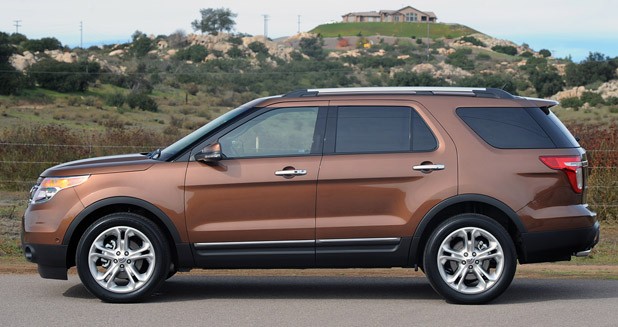
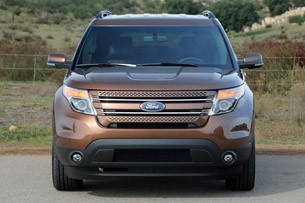
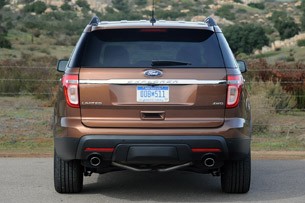
To drive home the Explorer's reinvention, Ford designers have wrapped the 2011 in muscular sheetmetal that makes the exit vehicle look as dated and dowdy as... well... it is. Using the D4 chassis shared with the Flex and Lincoln MKT limited Ford's designers somewhat, as the architecture's hard points dictated a high cowl and nose, and that naturally contributes to a slab-sided look. Ford has mitigated this through design tricks like prominent fender flares, deep-draw indented door panels and a clamshell hood.
Ford's now trademark grille form has been given an update with a pair of slim chrome bands between the three bars, along with wraparound wing-shaped headlamps that give the Explorer a technical, modern appearance. An aggressively raked C-pillar and blacked-out B- and D-pillars imbue the profile with a sense of forward motion and cut visual weight. Out back, the story is more conventional, with a traditional one-piece liftgate and full-width chrome garnish bookended by taillights that echo the headlamps' wing form. With a lower and significantly wider form than the outgoing Explorer, this new fifth-generation model appears more masculine than most crossovers – doubtlessly an intentional tack, as Ford will continue to market this vehicle as an SUV, not a CUV.
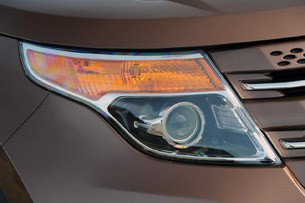
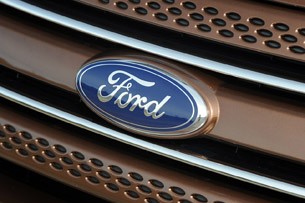
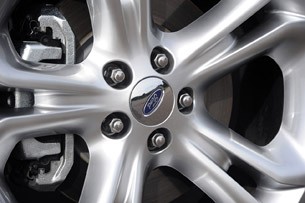
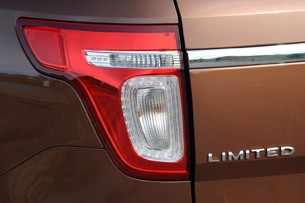
In order to do that, Ford had to make sure there was some starch in the Explorer's trousers. For the moment, the sole powerplant offering is Ford's all-aluminum 3.5-liter Ti-VCT V6, an engine that incorporates twin independent variable camshaft timing to realize a solid 290 horsepower at 6,500 rpm and 255 pound-feet of torque at 4,000 rpm. For reference, that's the same horsepower figure as the 3.6-liter V6 in its archrival, the similarly crossoverfied 2011 Dodge Durango (the latter makes out with five additional pound-feet, albeit with 800 more revs on the counter).
And while the Dodge gets by with an elderly five-speed automatic transmission, all Explorers receive a six-speed 'swapper. The XLT and Limited models even receive a +/- thumb rocker on the gearshift lever, but we'd have preferred a PRNDL gate and/or paddles. Of course, Dodge also offers a more powerful 5.7-liter Hemi V8, while Ford will go the other direction when a 2.0-liter twin-turbocharged EcoBoost four-cylinder goes on sale later in 2011, an engine that should deliver similar performance to the 3.5 (237 hp @ 5,500 rpm and 250 lb.-ft. from 1,750 rpm) with fuel economy that's better than the V6's already commendable 17 miles per gallon city and 25 mpg highway ratings (front-wheel drive).

Thus far, we've had a couple of opportunities to sample the new Explorer – first at Ford's Romeo, Michigan proving grounds both on- and off-road, and secondly on the winding roads outside of Hell (yes, really) during a big roundup of nominees for North American Car and Truck of the Year. (Oh, and our photographer, Drew Phillips, took these photos at a media event in San Diego). Having experienced the Expy over a wide variety of conditions, it's impossible not to be struck by how well-rounded a package it truly is.
When driven back-to-back with a 2011 Jeep Grand Cherokee on Ford's handling course, the Explorer was at once more composed, quieter and confidence-inspiring. Portions of the Blue Oval's circuit have been deliberately designed to upset a vehicle's balance, with mid-corner bumps, blind corners and whooping sections where the road quickly rises and falls. Admittedly, comparing the three-row Ford to the two-row Jeep is less-than-ideal (the new Durango was not yet on the market for testing), but given their somewhat different sizes and missions, it's impossible to ignore how much more settled the longer-wheelbase Ford felt across big road undulations, and indeed, how much quicker and keener its electric power steering system's turn-in felt (2.8 turns lock-to-lock vs. 3.67 does that sort of thing).
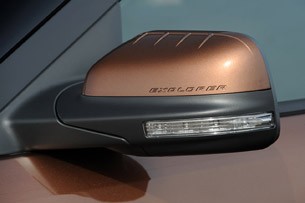
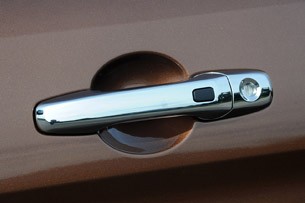
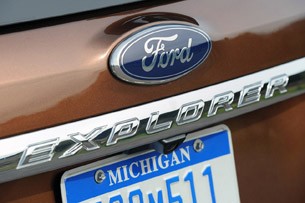
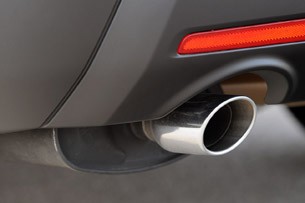
A particular part of the course where the tarmac dropped away to the right immediately after cresting a ridge allowed for some sphincter-clenching moments at highway speeds. We experienced some disconcerting behavior in the Jeep when it unsettled a bit as we turned starboard to make the corner, as if the rear suspension was oscillating both vertically and somewhat laterally as well. Despite sounding like something out of a Victoria's Secret catalog, Ford's Curve Control technology repeatedly helped the same maneuver feel much less unnerving in the Explorer.
Basically, Curve Control is a program that ties into the Explorer's stability and roll control hardware network that works to detect when a driver enters a corner too quickly. The system reacts by applying braking individually to all four corners as necessary – far more aggressively than ESC alone would. We were able to deliberately and more confidently take the same section of the circuit at higher (frankly inadvisable) speeds and not end up in the trees thanks to CC.
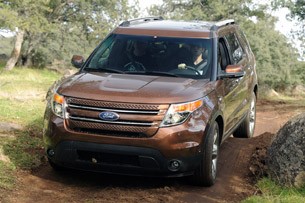
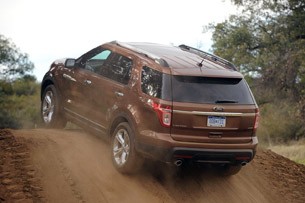
The story was much the same on the bucolic country roads around Hell, where back-to-back drives against the Grand Cherokee again revealed a more agreeable ride and handling balance – even on 20-inch Hankook Optimo tires. The long and short of it is that this chassis has been very well-sorted, and it could probably deal quite handily with more power than what the 3.5 or the 2.0T will be able to dish out.
All-in, Ford says it benchmarked premium 'utes like the BMW X5 and Audi Q7 for dynamics, and while we're not ready to put the Explorer in that company, we wouldn't turn down the chance for a back-to-back comparison drive, either.
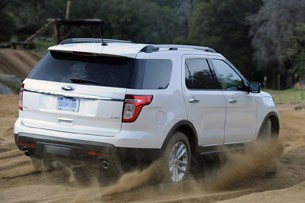
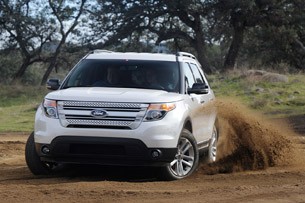
With the Explorer's transition to a unibody, improved on-road performance was all but a given – but how about off-road? Ford put us on a portion of its off-road course for back-to-back drives of an all-wheel-drive Explorer against a Toyota 4Runner. The battery of challenges included a couple of deeply rutted rails, a particularly steep hill descent and a dirt playpen of sorts. The body-on-frame Toyota is decidedly off-road oriented, and Ford officials we rode along with couldn't deny that both it and the Jeep are ultimately more capable for traversing hostile terrain – after all, both were designed with that functionality as a primary goal. But what surprised us was how well the skid-plate-free Explorer handled the course – and seemingly with much less drama.
The secret? The Explorer's new Terrain Management rotary controller that allows the driver to pre-select the best powertrain performance parameters for a given terrain. Among those parameters that Terrain Management has its silicon hands on? Engine and throttle calibrations, transmission shift patterns and the stability and traction-control systems. The four modes on the center console-mounted dial consist of Normal, Mud and Ruts, Sand and Snow. If that sounds eerily similar to Land Rover's Terrain Response system, it should come as no surprise because the English marque was under the Blue Oval's control when the system was first developed.

Throughout the challenge, the Explorer faithfully scrabbled everywhere the 4Runner did, but with notably less head-toss from its four-wheel independent suspension and indeed, fewer creaks from its body structure. There was even less teeth-gnashing during the hill descent, as the Ford's technology was both easier to summon (the Toyota requires a surprising amount of button and lever pushing to optimize it for downhill performance) and quieter in operation. Again, none of this is to deny that the 4Runner (or indeed, the Jeep we left back on the handling course) is ultimately more capable off-road than the Explorer, but we were struck by the surprising amount of capability that's built into the Ford – certainly plenty of capability for weekend woodsmen, beachgoers and ski holidays. Either way, when it comes time to pack up the weekend cottage and escape from the Dueling Banjos on a snaking dirt road, we'd take the Explorer every time.
Speaking of cabins, the Explorer's is a fine one – so fine, in fact, that it not only feels several generations ahead of the interior in the outgoing model, it might just be best-in-class. Sporting an uncluttered look and high-quality, feel-good plastics, it's a pleasant place to be. Second row accommodations are similarly comfortable, but despite the Explorer's substantial footprint (it's 197.1-inches long, shadowing its predecessor by nearly four inches), the third row access and accommodations are competitive but won't thrill those used to minivans. We've recently come to expect top-drawer tech from Dearborn, and it's here in force, with an improved SYNC system vying for dashboard space with available niceties like MyFord Touch (tremendously powerful but still a bit fiddly) and Wi-Fi, along with a battery of available safety features like industry-first seatbelt airbags in the second row and a blind spot and cross-traffic detection system.
One note: On uplevel models with the Sony stereo system like the Limited seen in our photos, all of the HVAC functions are operated via capacitive touch switches that look sleek but can be hard to locate by feel. Models without the premium audio share many similarities but enjoy a simpler rotary knob for fan speed. At least SYNC can also be used for voice-command temperature changes.
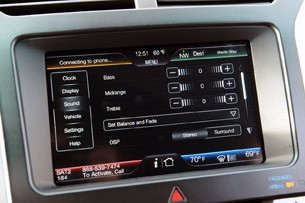
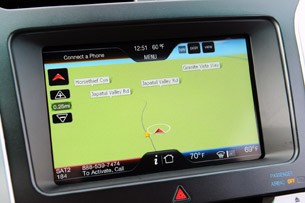
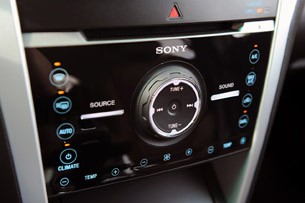
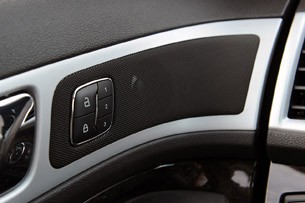
With its transition to stressed skin construction and a smaller displacement engine, the Explorer has lost towing capacity – the 2010 could be outfitted to pull up to 7,115 pounds and the new one cries uncle at 5,000, though the 2011 also has trailer brake and sway control for added safety. For comparison's sake, a V8 Durango can actually haul substantially more at 7,400 pounds. Still, 5,000 pounds is more than enough to tote around a good-sized boat, and if you're really into towing huge loads, chances are you aren't looking at a mid-size sport utility anyhow.
With three trims (base, XLT and Limited), pricing on Explorer ranges from $28,995 for a front-wheel-drive entry-level model to $39,995 for a limited AWD before options – numbers that put the Explorer right in the thick of the hunt.
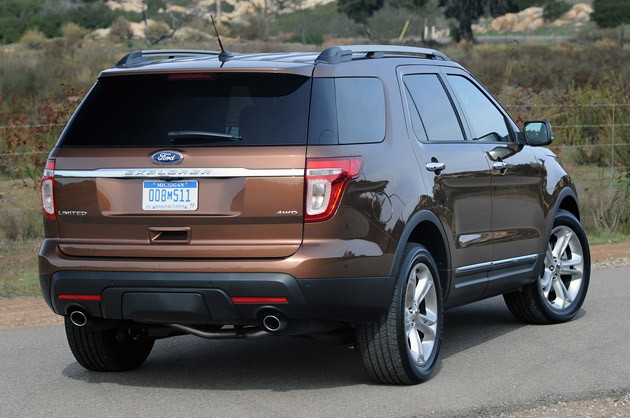
So, has Ford made the right bet by keeping the Explorer name for such a different vehicle? After some initial reluctance, we think so. First off, Ford has already shown that it can successfully market and reinvent a tarnished brand with the 2010 Taurus. Secondly, the new Explorer has been comprehensively improved in nearly every aspect of how most people actually use their vehicles, and it should be far more attractive to crossover buyers who would have never considered the 2010 model. With some six million Explorers built since 1990 and a truckload of returning buyers, Ford now has an excellent new model to sell them – buyers that might have otherwise been turned off by something as different as the Flex.
There may have been a lot of arched eyebrows leading up to the 2011 Explorer, but after driving it, the only looks of surprise are likely to be accompanied by feelings of delight.
Photos copyright ©2010 Drew Phillips / AOL
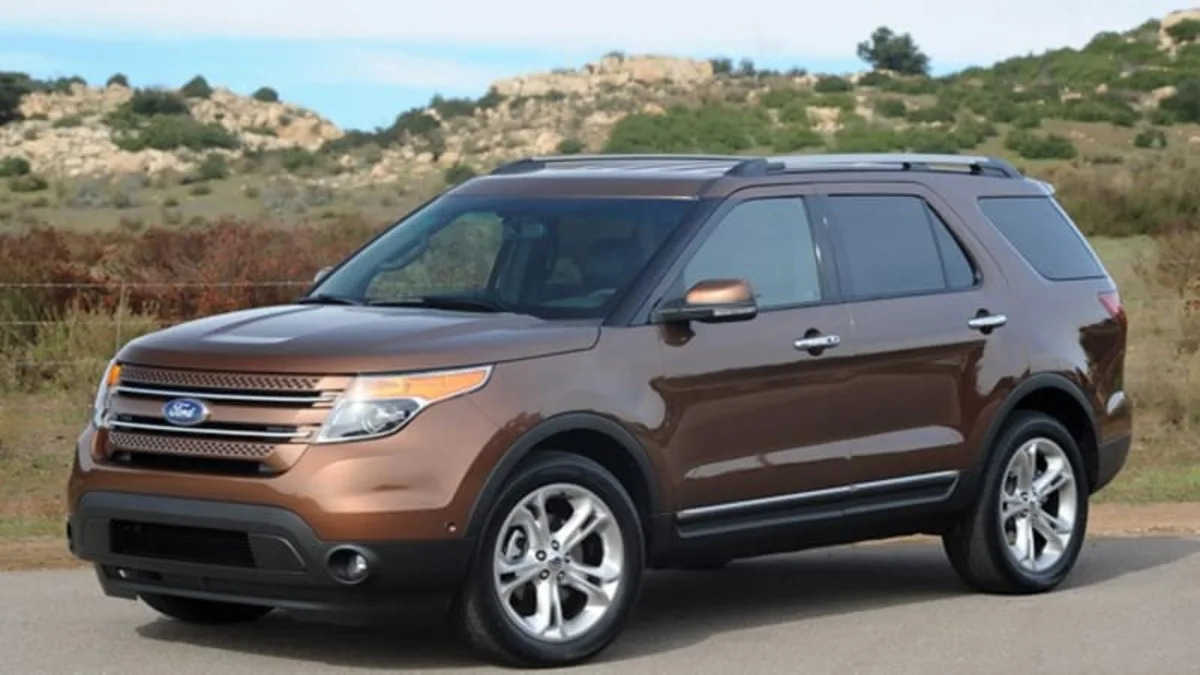

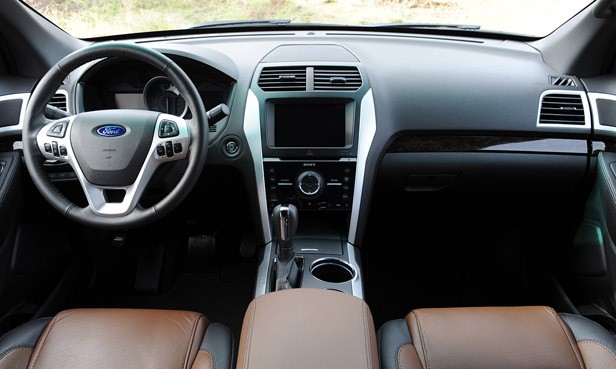
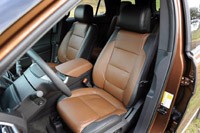
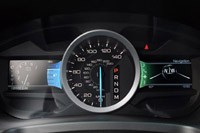
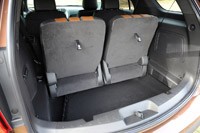

Sign in to post
Please sign in to leave a comment.
Continue